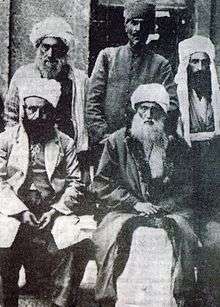Sheikh Said
Sheikh Said of Palu or Piran (Kurdish: شێخ سەعیدی ,Şêx Seîd,[1][2] 1865 – June 29, 1925) was a Zaza sheikh[3] and one of the leaders of Kurdish rebellion, also known as the Sheikh Said Rebellion.[4]

He was originally from Çılsütun, Bismil,[5][6] but his family moved to today's Dicle district of Diyarbakır Province later moved to Hınıs, Erzurum. He was a revered sheikh of the Naqshbandi order.[7]
He was captured in mid-April 1925 after being tricked by Turkish troops, commanded by Ali Riza Artunkal.[8]He was condemned to death by the Independence Tribunal in Diyarbakır on the 28 June 1925 and hanged the next day in Diyarbakır with 47 of his followers.[9] His remains were buried in an anonymous mass grave in order to prevent his memorization by the Kurds.[10]
His grandson, Abdülmelik Fırat, was a member of parliament.[11] Fırat says that his ancestors were not involved in politics until his grandfather, for they had cordial relations with the Ottoman elite.
The actress Belçim Bilgin is his great grand niece.[12]
References
| Wikimedia Commons has media related to Sheikh Said. |
- "Şêx Seîd û hevalê ey Amed hetê PAKî ra amê yadkerdene Kaynak: Şêx Seîd û hevalê ey Amed hetê PAKî ra amê yadkerdene" (in Kurdish). Retrieved 22 December 2019.
- "شۆڕشی شێخ سهعیدی پیران" (in Kurdish). Retrieved 22 December 2019.
- Uğur Ümit Üngör, The Making of Modern Turkey:Nation and State in Eastern Anatolia, 1913-1950, p. 111, Oxford University Press, 2011, ...member of a Zaza family originally from Piran and revered sheikh of the Sharia Naqshbandi Sufi order...
- Olson, Robert (1989). "The Emergence of Kurdish Nationalism and the Sheikh Said Rebellion, 1880-1925," University of Texas Press. Archived September 17, 2008, at the Wayback Machine
- "ŞEYH SAİD".
- "Muharrem".
- Ekinci, Ekrem Buğra (2015-07-03). "A traitor or a hero? The execution of Sheikh Said". Daily Sabah. Retrieved 2020-04-16.
- Tucker, William F. (2009-02-02). "The Rebellion of Sheikh-Said". Kurdmania (in German). Retrieved 2009-02-23.
- Üngör, Umut. "Young Turk social engineering : mass violence and the nation state in eastern Turkey, 1913- 1950" (PDF). University of Amsterdam. p. 243. Retrieved 16 April 2020.
- Üngör, Umut. "Young Turk social engineering : mass violence and the nation state in eastern Turkey, 1913- 1950" (PDF). University of Amsterdam. p. 350. Retrieved 16 April 2020.
- Kilic, Ecevit (2008-10-27). "CHP, dedemin gömüldüğü yere halkevi açtı". Sabah (in Turkish). Retrieved 2009-01-04.
- ÇAPA, İzzet. "13 yaşında ölümle burun buruna geldim". www.hurriyet.com.tr (in Turkish). Retrieved 2020-04-16.